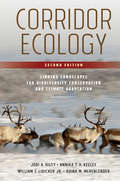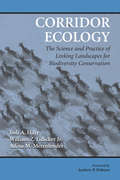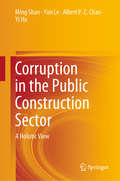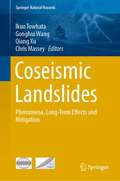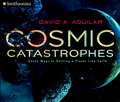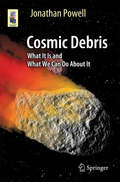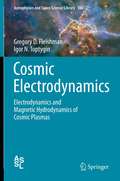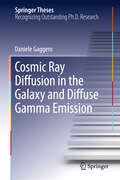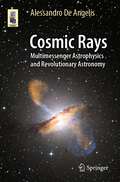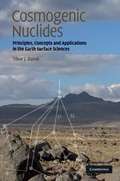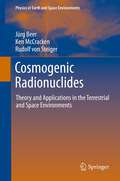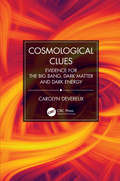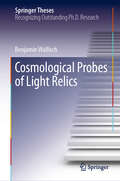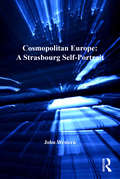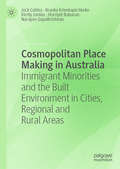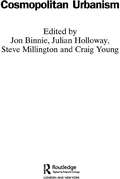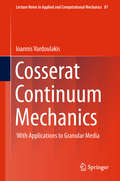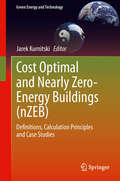- Table View
- List View
Corridor Ecology, Second Edition: Linking Landscapes for Biodiversity Conservation and Climate Adaptation
by Jodi A. Hilty William Z. Lidicker Jr. Annika T.H. Keeley Adina M. MerenlenderMigrating wildlife species across the globe face a dire predicament as their traditional migratory routes are cut off by human encroachment. Forced into smaller and smaller patches of habitat, they must compete more aggressively for dwindling food resources and territory. This is more than just an unfortunate side effect of human progress. As key species populations dwindle, ecosystems are losing resilience and face collapse, and along with them, the ecosystem services we depend on. Healthy ecosystems need healthy wildlife populations. One possible answer? Wildlife corridors that connect fragmented landscapes.This new and expanded second edition of Corridor Ecology: Linking Landscapes for Biodiversity Conservation and Climate Adaptation captures the many advances in the field over the past ten years. It builds on concepts presented in the first edition on the importance and practical details of maintaining and restoring land connectivity. New to this edition is a guest-edited chapter on ecological connectivity in oceans, including a detailed discussion on pelagic marine corridors and how coastal corridors can provide critical connectivity between marine protected areas. Another new chapter considers the effects of climate change on habitat and offers recommendations on designing effective corridors as landscapes change with shifting climate conditions. The book also includes a discussion of corridors in the air for migrating flying species, from birds to bats, butterflies, and even plant propagules—a concept so new that a term to describe it has yet to be coined. All chapters are thoroughly revised and updated.Practitioners as well as serious scholars of landscape ecology and the science of protecting biodiversity will find this new edition of corridor ecology science an indispensable resource.
Corridor Ecology: The Science and Practice of Linking Landscapes for Biodiversity Conservation
by Adina Merenlender Jodi A. Hilty Andrew P. Dobson William Z. Lidicker Jr.Corridor Ecology presents guidelines that combine conservation science and practical experience for maintaining, enhancing, and creating connectivity between natural areas with an overarching goal of conserving biodiversity. It offers an objective, carefully interpreted review of the issues and is a one-of-a-kind resource for scientists, landscape architects, planners, land managers, decision-makers, and all those working to protect and restore landscapes and species diversity.
Corruption in the Public Construction Sector: A Holistic View
by Yi Hu Ming Shan Yun Le Albert P.C. ChanThis book is committed to provide a holistic view of corruption in the public construction sector, a sector that has been perceived as the most corrupt in the world. Relying on the new findings achieved from a series of qualitative and quantitative studies, this book unveils the specific forms of corruption, the principal causes of corruption, and the prevailing anti-corruption strategies that are used by the current practice. Furthermore, this book provides two metrics that can assess the potential of corruption and the risk of collusion in given public construction projects, respectively. This book will enhance industry and research communities’ understandings of corruption in the public construction sector. It is also informative to policy-makers and can help them come up with some more effective strategies to eliminate corruption in the public construction sector.
Coseismic Landslides: Intelligent Prediction and Recognition
by Lizhe Wang Xuewen Wang Xianmin Wang Haixiang Guo Qiyuan Yang Aomei ZhangFocusing on Habitable Earth for sustainability, this book develops novel and sophisticated deep learning algorithms and explores their successful application in intelligent prediction and recognition of coseismic landslides. These algorithms have originality and unique advantages in relatively high accuracy, low false alarms, strong generalization, and good interpretability. They were successfully applied in a series of violent earthquakes occurring worldwide from 2008 to 2022. This book provides significant techniques to support the 72-hour &“golden window&” for survivors in emergency rescue and to instruct postseismic rational reconstruction and development in society and economy. With cutting-edge algorithms and international urgent disaster-mitigating demands, this book caters to geoscientists, environmentalists, engineering geologists, and hazard geologists. It also appeals graduate students in the above fields.
Coseismic Landslides: Phenomena, Long-Term Effects and Mitigation (Springer Natural Hazards)
by Qiang Xu Ikuo Towhata Gonghui Wang Chris MasseyThis book is the result of an elaborate project initiated by the Joint Technical Committee (JTC-1) of 1) the International Society for Soil Mechanics and Geotechnical Engineering, 2) the International Association for Engineering Geology and the Environment, 3) the International Society for Rock Mechanics, and 4) the International Geotextile Society, with the focus on natural slopes and landslides. The framework of the book sets out the steps, based on recent disaster experiences in the twenty-first century, leading to the assessment of earthquake-induced landslide hazards. It contains: 1) important cases of landslides triggered by earthquakes around the world; 2) investigation into the characteristics of ground motion site response; 3) methods to determine landslide susceptibility and triggering thresholds and their comparative study; and 4) commentary on the production of earthquake-induced landslide hazard maps. All the contents are the result of the latest research on related areas. The book is a valuable resource for researchers, designers, consultants, academicians, government officials, and all others who are involved in the mitigation of coseismic landslides. The book contributes toward the development of a new chapter in disaster prevention and mitigation of landslides induced by earthquakes.
Cosmic Catastrophes: Seven Ways to Destroy a Planet Like Earth
by David AguilarIn the vast realm of outer space, accidents happen all the time. Things bump into each other. Stars blow up. Space rocks smash into planets. Black holes gobble up everything in their path. The sun is burning out. A comet swarm is bearing down. Any of this could change--or even eliminate--life on a planet like Earth. Countdown to cosmic catastrophes! From asteroid hit to alien invasion, astronomer David Aguilar builds the scientific case for seven extreme events that could impact Earth. (Though not as we know it: most of these catastrophes are way down the cosmic line . . . we hope!) He tells an exciting nonfiction story about how and why these space catastrophes could happen and then creates beautiful, original art to show just how devastatingly spectacular it will be when any one of these seven "big ones" hit! The SMITHSONIAN INSTITUION is the world's largest museum and research complex. Founded in 1846, it includes nineteen museum and galleries, the National Zoological Park, and nine research facilities. Its vast collections house 138 million artifacts, specimens, and works of art, which represent our nation's rich heritage, art from across the globe, and the immense diversity of the natural and cultural world.
Cosmic Debris: What It Is and What We Can Do About It (Astronomers' Universe)
by Jonathan PowellThis book examines the mysterious and the well-studied debris in Earth's crowded neighborhood. From orbiting comets to the workings of the Asteroid Belt, and from meteor showers to our home-grown network of orbiting satellites, the full diversity of space objects and the debris they create is explored. Powell also discusses some of the current research techniques used to find potentially harmful rogue elements, with an emphasis on keeping watch for any objects that may intersect Earth's orbit. Such bodies also impact other worlds, and much has been learned from observing these encounters. The information in this book is intended to foster thought about the universe in which we live, but without overloading its readers with numbers and lecture-room analysis. Like a good thriller, it allows its readers to pace themselves with the story and, by the end, encourages them to draw their own conclusions.
Cosmic Electrodynamics: Electrodynamics and Magnetic Hydrodynamics of Cosmic Plasmas (Astrophysics and Space Science Library #388)
by Igor N. Toptygin Gregory D. FleishmanThis book presents the fundamental concepts of the theory, illustrated by numerous examples of astrophysical applications. Classical concepts are combined with new developments and the authors demarcate what is well established and what is still under debate. To book illustrates how apparently complicated phenomena can be addressed and understood using well-known physical principles and equations within appropriate approximations and simplifications. For this purpose, a number of astrophysical examples are considered in greater detail than what is normally presented in a regular textbook. In particular, a number of nonlinear self-consistent models are considered, which is motivated by the latest observational data and modern theory.
Cosmic Ray Diffusion in the Galaxy and Diffuse Gamma Emission (Springer Theses)
by Daniele GaggeroThe original work presented in this thesis constitutes an important contribution to modern Cosmic Ray (CR) physics, and comes during one of the most exciting periods of this field. The first part introduces a new numerical code (DRAGON) to model the CR propagation in our Galaxy. The code is then used to perform a combined analysis of CR data, making it possible to determine their propagation properties with unprecedented accuracy. The second part is dedicated to a theoretical interpretation of the recent crucial experimental results on cosmic electron and positron spectra (PAMELA, Fermi-LAT experiments). Using the tools developed in the first part of the thesis, the author convincingly argues for the existence of a new spectral component, which could arise either from local astrophysical sources, such as pulsars, or from Dark Matter annihilation or decay. This thesis is a highly advanced work; the methods, analysis and results are clearly and carefully presented. This work is set to become an important reference document for any future work in this area.
Cosmic Ray Neutron Sensing: Estimation of Agricultural Crop Biomass Water Equivalent
by Ammar Wahbi Lee Heng Gerd DerconThis open access book provides methods for the estimation of Biomass Water Equivalent (BEW), an essential step for improving the accuracy of area-wide soil moisture by cosmic-ray neutron sensors (CRNS). Three techniques are explained in detail: (i) traditional in-situ destructive sampling, (ii) satellite based remote sensing of plant surfaces, and (iii) biomass estimation via the use of the CRNS itself. The advantages and disadvantages of each method are discussed along with step by step instructions on proper procedures and implementation.
Cosmic Rays: Multimessenger Astrophysics and Revolutionary Astronomy (Astronomers' Universe)
by Alessandro De AngelisIn recent years, cosmic rays have become the protagonists of a new scientific revolution. We are able today to film the Universe with telescopes of completely novel conception, recording information from many different messengers and accessing previously unknown cosmic regions.Written by a recognized authority in physics, this book takes readers on a captivating journey through the world of cosmic rays, their role in the revolutionary field of multi-messenger astronomy, their production from powerful accelerators close to the surfaces of black holes and compact objects, reaching the highest levels of energy observed in nature, and the implications this has for our understanding of the Universe. Through the stories of pioneering scientists, explorations of cutting-edge technologies, and simple explanations related to particle physics, quantum mechanics, and astrophysics, the book provides an illuminating state-of-the-art introduction to the current state of high-energy astrophysics. The book was written in straightforward yet rigorous language, so as to be accessible to the greater public. For those curious about the cosmos and cosmic gamma rays, nuclei, neutrinos, and gravitational waves, from casual observers to professional astronomers and physicists, the book is a must-read, offering a thrilling adventure into the future of astronomy and particle physics.
Cosmochemistry
by Harry McSween, Jr Gary HussCosmochemistry is a rapidly evolving field of planetary science and the second edition of this classic text reflects the exciting discoveries made over the past decade from new spacecraft missions. Topics covered include the synthesis of elements in stars, behaviour of elements and isotopes in the early solar nebula and planetary bodies, and compositions of extra-terrestrial materials. Radioisotope chronology of the early Solar System is also discussed, as well as geochemical exploration of planets by spacecraft, and cosmochemical constraints on the formation of solar systems. Thoroughly updated throughout, this new edition features significantly expanded coverage of chemical fractionation and isotopic analyses; focus boxes covering basic definitions and essential background material on mineralogy, organic chemistry and quantitative topics; and a comprehensive glossary. An appendix of analytical techniques and end-of-chapter review questions, with solutions available at www.cambridge.org/cosmochemistry2e, also contribute to making this the ideal teaching resource for courses on the Solar System's composition as well as a valuable reference for early career researchers.
Cosmogenic Nuclides
by Tibor J. DunaiThis is the first book to provide a comprehensive and state-of-the-art introduction to the novel and fast-evolving topic of in-situ produced cosmogenic nuclides. It presents an accessible introduction to the theoretical foundations, with explanations of relevant concepts starting at a basic level and building in sophistication. It incorporates, and draws on, methodological discussions and advances achieved within the international CRONUS (Cosmic-Ray Produced Nuclide Systematics) networks. Practical aspects such as sampling, analytical methods and data-interpretation are discussed in detail and an essential sampling checklist is provided. The full range of cosmogenic isotopes is covered and a wide spectrum of in-situ applications are described and illustrated with specific and generic examples of exposure dating, burial dating, erosion and uplift rates and process model verification. Graduate students and experienced practitioners will find this book a vital source of information on the background concepts and practical applications in geomorphology, geography, soil-science, and geology.
Cosmogenic Radionuclides: Theory and Applications in the Terrestrial and Space Environments (Physics of Earth and Space Environments)
by Jürg Beer Ken Mccracken Rudolf Von SteigerCosmogenic radionuclides are radioactive isotopes which are produced by natural processes and distributed within the Earth system. With a holistic view of the environment the authors show in this book how cosmogenic radionuclides can be used to trace and to reconstruct the history of a large variety of processes. They discuss the way in which cosmogenic radionuclides can assist in the quantification of complex processes in the present-day environment. The book aims to demonstrate to the reader the strength of analytic tools based on cosmogenic radionuclides, their contribution to almost any field of modern science, and how these tools may assist in the solution of many present and future problems that we face here on Earth. The book provides a comprehensive discussion of the basic principles behind the applications of cosmogenic (and other) radionuclides as environmental tracers and dating tools. The second section of the book discusses in some detail the production of radionuclides by cosmic radiation, their transport and distribution in the atmosphere and the hydrosphere, their storage in natural archives, and how they are measured. The third section of the book presents a number of examples selected to illustrate typical tracer and dating applications in a number of different spheres (atmosphere, hydrosphere, geosphere, biosphere, solar physics and astronomy). At the same time the authors have outlined the limitations of the use of cosmogenic radionuclides. Written on a level understandable by graduate students without specialist skills in physics or mathematics, the book addresses a wide audience, ranging from archaeology, biophysics, and geophysics, to atmospheric physics, hydrology, astrophysics and space science.
Cosmological Clues: Evidence for the Big Bang, Dark Matter and Dark Energy
by Carolyn DevereuxDid the Universe have a beginning? Will it have an end? Or has it always been the same, never changing? This is the subject of cosmology; the study of the Universe, and this book provides a perfect introduction to the subject for anyone that is interested in the wonders of our UniverseThis book provides an accessible overview of the Standard Model of Cosmology, which is explained in six Cosmological Clues, including evidence for the Big Bang and dark matter and dark energy - the keystones of modern cosmology. It takes readers through some of the most exciting questions in cosmology, such as what evidence do we have that the Universe started from the Big Bang? Has dark matter been observed? Will we ever know what dark energy is? Are the multiverses real? And could the Universe be a hologram? This book is an ideal guide for anyone interested in finding out more about our Universe. It will be of interest to those studying cosmology for the first time, including readers without a scientific background, who have an interest in looking up at the stars and wondering where they all came from!Key features: Contains the latest evidence for the Big Bang, dark matter, and dark energy and explores exciting scientific ideas, such as inflation and multiverses Provides a clear explanation of the main theories of how the Universe evolved based on key observations - the Cosmological Clues Gives the reader a concise introduction to the scientific process, using cosmology as the example, and explores why it has been so successful in creating the technologies we have today
Cosmological Probes of Light Relics (Springer Theses)
by Benjamin WallischThe wealth of recent cosmic microwave background and large-scale structure data has transformed the field of cosmology. These observations have not only become precise enough to answer questions about the universe on the largest scales, but also to address puzzles in the microscopic description of Nature. This thesis investigates new ways of probing the early universe, the properties of neutrinos and the possible existence of other light particles. In particular, based on detailed theoretical insights and novel analyses, new evidence for the cosmic neutrino background is found in the distribution of galaxies and in cosmic microwave background data. This tests the Standard Model of particle physics and the universe back to a time when it was about one second old. Furthermore, it is demonstrated that future observations will be capable of probing physics beyond the Standard Model since they can achieve a particular target which would either allow the detection of any light particles that have ever been in thermal equilibrium or imply strong bounds on their properties.
Cosmological Readings of Contemporary Australian Literature: Unsettling the Anthropocene (Routledge Environmental Literature, Culture and Media)
by Kathrin Bartha-MitchellThis book presents an innovative and imaginative reading of contemporary Australian literature in the context of unprecedented ecological crisis. The Australian continent has seen significant, rapid changes to its cultures and land-use from the impact of British colonial rule, yet there is a rich history of Indigenous land-ethics and cosmological thought. By using the age-old idea of ‘cosmos’—the order of the world—to foreground ideas of a good order and chaos, reciprocity and more-than-human agency, this book interrogates the Anthropocene in Australia, focusing on notions of colonisation, farming, mining, bioethics, technology, environmental justice and sovereignty. It offers ‘cosmological readings’ of a diverse range of authors—Indigenous and non-Indigenous—as a challenge to the Anthropocene’s decline-narrative. As a result, it reactivates ‘cosmos’ as an ethical vision and a transculturally important counter-concept to the Anthropocene. Kathrin Bartha-Mitchell argues that the arts can help us envision radical cosmologies of being in and with the planet, and to address the very real social and environmental problems of our era. This book will be of particular interest to scholars and students of Ecocriticism, Environmental Humanities, and postcolonial, transcultural and Indigenous studies, with a primary focus on Australian, New Zealand, Oceanic and Pacific area studies.
Cosmopolitan Europe: A Strasbourg Self-portrait (Heritage, Culture and Identity)
by John WesternThe past hundred years of Europe are distilled in the experiences of the citizens of Strasbourg. From the turn of the twentieth century until 1945, Europe's ruling idea of nationalism rendered Strasbourg/Straßburg the prize in a tug-of-war between the two greatest continental powers, France and Germany. Then, in the immediate post-war period, ideals for European unity set up various European institutions, some headquartered in Strasbourg, which have gradually created a partially supranational Europe. At the end of the 1950s, a third theme arises: the large-scale settling in Strasbourg and other such richer, western European cities of persons from poorer lands, frequently ex-colonial territories, whose appearance and cultural practices render them essentially "different" to local eyes: expressions of racism thereby jostle with professions of multiculturalism. Now in the globalisation era, the issue of "immigration" has broadened yet further into transnationalism: the experience of persons who are embedded in varying manner in both Strasbourg and in their land of origin. Based on in-depth, lively interviews with 80 men and 80 women ranging from 101 to 20 years, and from all over the world (France, Germany, Alsace-Lorraine, Portugal, Italy, ex-Yugoslavia, Albania, Algeria, Morocco, Turkey, Cameroon, and Afghanistan amongst other countries), the author draws out of these compelling testimonies all sorts of compelling insights into issues of identity, race, nationality, culture, politics, heritage and representation, giving a unique and valuable view of what it means (and has meant over the past century) to be a European.
Cosmopolitan Place Making in Australia: Immigrant Minorities and the Built Environment in Cities, Regional and Rural Areas
by Jock Collins Branka Krivokapic-Skoko Kirrily Jordan Hurriyet Babacan Narayan GopalkrishnanThis book looks at the historical and contemporary impact of minority immigrant and ethnic communities on the built and social environment in Australian cities, rural and regional areas. The emphasis is on the changing social use of these buildings – places of worship, ethnic clubs and community associations, immigrant restaurants and retail outlets, museums, memorials and landmarks and other places and spaces created by immigrant communities – rather than on their architectural merit. These places and spaces are sites of bridging and bonding social capital, of social interaction between immigrant communities and their local communities. In both the Australian cities and the ‘bush’ (an Australian colloquial term for non-metropolitan dwellers), the book investigates how the places built and used by minority ethnic communities have transformed Australian life in complex and sometimes contradictory ways. In Sydney, Brisbane and Perth, the book investigates the historical development of Chinatowns and their contemporary dynamics.
Cosmopolitan Urbanism
by Jon Binnie Steve Millington Julian Holloway Craig YoungIn order to attract investment and tourism, cities are increasingly competing to re-brand themselves as cosmopolitan, and in recent years, cosmopolitanism has become the focus of considerable critical attention in academia. Here, renowned editors and contributors have come together to produce one of the first books to tackle cosmopolitanism from a geographical perspective. Central to the cosmopolitan process is how traditionally marginalized groups have become re-valued and reconstructed as a resource in the eyes of planners and politicians. This fascinating book examines the politics of these transformations by understanding the everyday practices of cosmopolitanism. Which forms of cultural difference are valued and which are excluded from this re-visioning of the contemporary city? Organized in three distinct parts, the book covers: production and consumption, and cosmopolitanism the spatialities of cosmopolitanism the deployment, mobilization and articulation of cosmopolitan discourses in policy-making and urban design. The volume is groundbreaking in examining the complex politics of cosmopolitanism in empirical case studies from Montreal to Singapore, London to Texas, Auckland to Amsterdam. With a strong editorial steer, including general and section introductions and a conclusion to guide the student reader, Cosmopolitan Urbanism employs a range of theoretical and empirical approaches to provide a grounded treatment essential for students of human geography, urban studies and sociology.
Cosmopolitical Ecologies Across Asia: Places and Practices of Power in Changing Environments (ISSN)
by David Sneath Hildegard Diemberger Riamsara KuyakanonCosmopolitical Ecologies Across Asia offers a unique insight into the non-human and spiritual dimensions of environmental management in a changing world.This volume presents a comparative, place-based exploration of landscapes across Asia and the entities, practices and knowledges that inhabit them. Rather than treating sacred mountains, terrains and water sources as self-contained, esoteric religious phenomena, the authors consider them within critical 'cosmopolitical ecologies' framings in which non-human entities are engaged as actors in the socio-political arena. The chapters include case studies of healing springs recognized by governments, and sacred mountains that are addressed by heads of states and Communist Party cadres, or that speak to the faithful through spirit mediums in a politics of re-enchantment. Contributors explore the diverse ways in which non-human entities such as forest spirits, reindeer, mountains and Buddhist Masters of the Land are engaged by humans to navigate environmental change and address a range of ecological threats from large-scale mining to climate change. Cosmopolitical ecologies approaches encompass the healing power of topography as well as transformative intimacies with other-than-human beings such as sparrows within an Islamic eco-theological poetic setting. In this light the book observes dynamic and creative processes of cosmological innovation including the repurposing of ritual to address challenges such as the Covid-19 epidemic.This book will be of great interest to students and scholars of environment and society across disciplinary perspectives in general, and to anthropologists, human geographers, political ecologists, indigenous studies, area studies, environmental sciences and environmental humanities scholars in particular.The Introduction to this book is freely available as a downloadable Open Access PDF at http://www.taylorfrancis.com under a Creative Commons Attribution-Non Commercial-No Derivatives (CC-BY-NC-ND) 4.0 license.
Cosmopolitical Ecologies Across Asia: Places and Practices of Power in Changing Environments (Routledge Environmental Humanities)
by Riamsara KuyakanonCosmopolitical Ecologies Across Asia offers a unique insight into the non-human and spiritual dimensions of environmental management in a changing world. This volume presents a comparative, place-based exploration of landscapes across Asia and the entities, practices and knowledges that inhabit them. Rather than treating sacred mountains, terrains and water sources as self-contained, esoteric religious phenomena, the authors consider them within critical 'cosmopolitical ecologies' framings in which non-human entities are engaged as actors in the socio-political arena. The chapters include case studies of healing springs recognized by governments, and sacred mountains that are addressed by heads of states and Communist Party cadres, or that speak to the faithful through spirit mediums in a politics of re-enchantment. Contributors explore the diverse ways in which non-human entities such as forest spirits, reindeer, mountains and Buddhist Masters of the Land are engaged by humans to navigate environmental change and address a range of ecological threats from large-scale mining to climate change. Cosmopolitical ecologies approaches encompass the healing power of topography as well as transformative intimacies with other-than-human beings such as sparrows within an Islamic eco-theological poetic setting. In this light the book observes dynamic and creative processes of cosmological innovation including the repurposing of ritual to address challenges such as the Covid-19 epidemic. This book will be of great interest to students and scholars of environment and society across disciplinary perspectives in general, and to anthropologists, human geographers, political ecologists, indigenous studies, area studies, environmental sciences and environmental humanities scholars in particular.
Cosmos
by Carl SaganThis visually stunning book with over 250 full-color illustrations, many of them never before published, is based on Carl Sagan's thirteen-part television series. <P><P>Told with Sagan's remarkable ability to make scientific ideas both comprehensible and exciting, Cosmos is about science in its broadest human context, how science and civilization grew up together. <P><P>The book also explores spacecraft missions of discovery of the nearby planets, the research in the Library of ancient Alexandria, the human brain, Egyptian hieroglyphics, the origin of life, the death of the Sun, the evolution of galaxies and the origins of matter, suns and worlds. <P><P>Sagan retraces the fifteen billion years of cos-mic evolution that have transformed matter into life and consciousness, enabling the Cosmos to wonder about itself. He considers the latest findings on life elsewhere and how we might communicate with the beings of other worlds. <P><P>Cosmos is the story of our long journey of discovery and the forces and individuals who helped to shape modern science, including Democritus, Hypatia, Kepler, Newton, Huygens, Champollion, Lowell and Humason. <P><P> Sagan looks at our planet from an extra-terrestrial vantage point and sees a blue jewel-like world, inhabited by a lifeform that is just beginning to discover its own unity and to ven-ture into the vast ocean of space.
Cosserat Continuum Mechanics: With Applications To Granular Media (Lecture Notes in Applied and Computational Mechanics #87)
by Ioannis VardoulakisThis textbook explores the theory of Cosserat continuum mechanics, and covers fundamental tools, general laws and major models, as well as applications to the mechanics of granular media. While classical continuum mechanics is based on the axiom that the stress tensor is symmetric, theories such as that expressed in the seminal work of the brothers Eugène and François Cosserat are characterized by a non-symmetric stress tensor. The use of von Mises motor mechanics is introduced, for the compact mathematical description of the mechanics and statics of Cosserat continua, as the Cosserat continuum is a manifold of oriented “rigid particles” with 3 dofs of displacement and 3 dofs of rotation, rather than a manifold of points with 3 dofs of displacement. Here, the analysis is restricted to infinitesimal particle displacements and rotations. This book is intended as a valuable supplement to standard Continuum Mechanics courses, and graduate students as well as researchers in mechanics and applied mathematics will benefit from its self-contained text, which is enriched by numerous examples and exercises.
Cost Optimal and Nearly Zero-Energy Buildings: Definitions, Calculation Principles and Case Studies (Green Energy and Technology)
by Jarek KurnitskiCost optimal and nearly zero energy performance levels are principles initiated by the European Union's (EU) Energy Performance of Buildings Directive which was recast in 2010. These will be major drivers in the construction sector in the next few years, because all new buildings in the EU from 2021 onwards are expected to be nearly zero energy buildings (nZEB). This book introduces the technical definitions, system boundaries, energy calculation methodology and input data needed to set primary energy based minimum/cost optimal and nZEB requirements in national energy frames. Worked examples are provided to illustrate the calculation of delivered, exported and primary energy, and renewable energy contribution. Five case studies of high performance nZEB office buildings across Europe are reported to show alternative technical solutions and to draw some general design rules based on completed nZEB buildings. Specific features of the nZEB design process, especially in the early stages, and architectural competitions are included. These describe important design issues in the scoping and conceptual design phase, allowing design streams to be controlled so that specified targets can be met. This book is intended for readers who need to be aware of or are working with the energy performance of buildings - for decision makers in public and private sectors, architects, engineers, construction clients, consultants, contractors, manufacturers and students. The editor of this book, Professor Jarek Kurnitski has made major contributions to the preparation of the European REHVA nZEB technical definition and has developed energy calculation frames for current Estonian and Finnish energy performance regulations. He is the leader of nZEB research at Tallinn University of Technology in Estonia and Aalto University in Finland, and he has over 300 publications.
